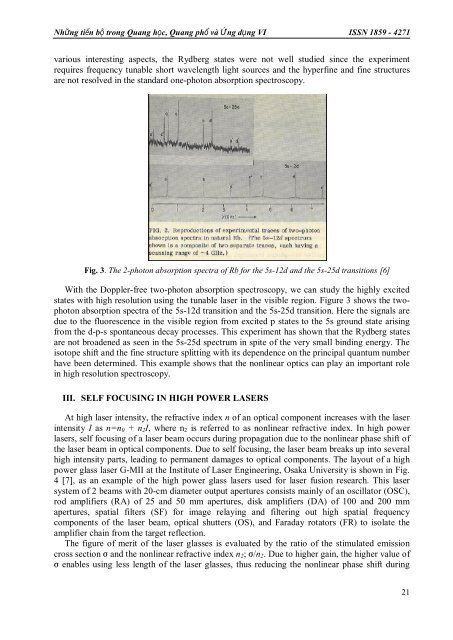Nhng tin b trong Quang hc, Quang ph và ng dng VI ISSN 1859 - 4271
Nhng tin b trong Quang hc, Quang ph và ng dng VI ISSN 1859 - 4271
Nhng tin b trong Quang hc, Quang ph và ng dng VI ISSN 1859 - 4271
You also want an ePaper? Increase the reach of your titles
YUMPU automatically turns print PDFs into web optimized ePapers that Google loves.
Nhữ<strong>ng</strong> tiến bộ <stro<strong>ng</strong>>tro<strong>ng</strong></stro<strong>ng</strong>> <stro<strong>ng</strong>>Qua<strong>ng</strong></stro<strong>ng</strong>> học, <stro<strong>ng</strong>>Qua<strong>ng</strong></stro<strong>ng</strong>> <stro<strong>ng</strong>>ph</stro<strong>ng</strong>>ổ và Ứ<strong>ng</strong> dụ<strong>ng</strong> <strong>VI</strong> <strong>ISSN</strong> <strong>1859</strong> - <strong>4271</strong>various interes<s<stro<strong>ng</strong>>tro<strong>ng</strong></stro<strong>ng</strong>>>tin</s<stro<strong>ng</strong>>tro<strong>ng</strong></stro<strong>ng</strong>>>g aspects, the Rydberg states were not well studied since the experimentrequires frequency tunable short wavele<strong>ng</strong>th light sources and the hyperfine and fine structuresare not resolved in the standard one-<stro<strong>ng</strong>>ph</stro<strong>ng</strong>>oton absorption spectroscopy.Fig. 3. The 2-<stro<strong>ng</strong>>ph</stro<strong>ng</strong>>oton absorption spectra of Rb for the 5s-12d and the 5s-25d transitions [6]With the Doppler-free two-<stro<strong>ng</strong>>ph</stro<strong>ng</strong>>oton absorption spectroscopy, we can study the highly excitedstates with high resolution usi<strong>ng</strong> the tunable laser in the visible region. Figure 3 shows the two<stro<strong>ng</strong>>ph</stro<strong>ng</strong>>otonabsorption spectra of the 5s-12d transition and the 5s-25d transition. Here the signals aredue to the fluorescence in the visible region from excited p states to the 5s ground state arisi<strong>ng</strong>from the d-p-s spontaneous decay processes. This experiment has shown that the Rydberg statesare not broadened as seen in the 5s-25d spectrum in spite of the very small bindi<strong>ng</strong> energy. Theisotope shift and the fine structure split<s<stro<strong>ng</strong>>tro<strong>ng</strong></stro<strong>ng</strong>>>tin</s<stro<strong>ng</strong>>tro<strong>ng</strong></stro<strong>ng</strong>>>g with its dependence on the principal quantum numberhave been determined. This example shows that the nonlinear optics can play an important rolein high resolution spectroscopy.III. SELF FOCUSING IN HIGH POWER LASERSAt high laser intensity, the refractive index n of an optical component increases with the laserintensity I as n=n 0 + n 2 I, where n 2 is referred to as nonlinear refractive index. In high powerlasers, self focusi<strong>ng</strong> of a laser beam occurs duri<strong>ng</strong> propagation due to the nonlinear <stro<strong>ng</strong>>ph</stro<strong>ng</strong>>ase shift ofthe laser beam in optical components. Due to self focusi<strong>ng</strong>, the laser beam breaks up into severalhigh intensity parts, leadi<strong>ng</strong> to permanent damages to optical components. The layout of a highpower glass laser G-MII at the Institute of Laser E<strong>ng</strong>ineeri<strong>ng</strong>, Osaka University is shown in Fig.4 [7], as an example of the high power glass lasers used for laser fusion research. This lasersystem of 2 beams with 20-cm diameter output apertures consists mainly of an oscillator (OSC),rod amplifiers (RA) of 25 and 50 mm apertures, disk amplifiers (DA) of 100 and 200 mmapertures, spatial filters (SF) for image relayi<strong>ng</strong> and filteri<strong>ng</strong> out high spatial frequencycomponents of the laser beam, optical shutters (OS), and Faraday rotators (FR) to isolate theamplifier chain from the target reflection.The figure of merit of the laser glasses is evaluated by the ratio of the stimulated emissioncross section σ and the nonlinear refractive index n 2 ; σ/n 2 . Due to higher gain, the higher value ofσ enables usi<strong>ng</strong> less le<strong>ng</strong>th of the laser glasses, thus reduci<strong>ng</strong> the nonlinear <stro<strong>ng</strong>>ph</stro<strong>ng</strong>>ase shift duri<strong>ng</strong>21















